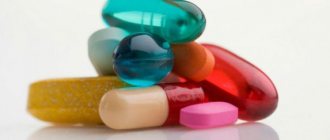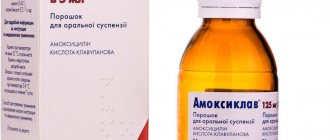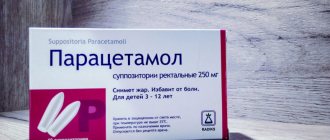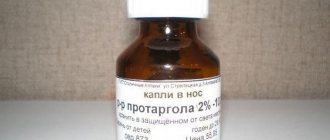Release form and composition
Josamycin is the main active ingredient of the drug. Vilprafen solutab is produced by the manufacturer in tablet form. The tablets are white or have a slight yellowish tint. On their surface is the inscription "IOSA" with a line on one side, and the inscription "1000" on the other. The tablet shape is oblong. The taste is sweet. Has a strawberry aroma.
1 tablet contains:
- Active substance: Josamycin -1000 mg, (equivalent to josamycin propionate) - 1067.66 mg.
- Excipients: Microcrystalline cellulose - 564.53 mg, hyprolose - 199.82 mg, sodium docusate - 10.02 mg, aspartame - 10.09 mg, colloidal silicon dioxide - 2.91 mg, strawberry flavor - 50.05 mg, magnesium stearate - 34.92 mg.
Pharmacodynamics
Antibacterial drug from the macrolide group. The mechanism of action is associated with disruption of protein synthesis in the microbial cell due to reversible binding to the 508 ribosomal subunit. In therapeutic concentrations, as a rule, it has a bacteriostatic effect, slowing down the growth and reproduction of bacteria. When high concentrations are created at the site of inflammation, a bactericidal effect is possible.
Josamycin is active against gram-positive bacteria (Staphylococcus spp., including methicillin-sensitive strains of Staphylococcus aureus), Streptococcus spp., incl. Streptococcus pyogenes and Streptococcus pneumoniae, Corynebacterium diphtheriae, Listeria monocytogenes, Propionibacterium acnes, Bacillus anthracis, Clostridium spp. Peptococcus spp., Peptostreptococcus spp.), gram-negative bacteria (Neisseria meningitidis, Neisseria gonorrhoeae, Moraxella catarrhalis, Bordetella spp. Brucella spp., Legionella spp., Haemophilus ducreyi, Haemophilus influenzae, Helicobacter pylori, Campylobacter jejuni), sensitivity Bacteroides fragilis may be variable), Chlamydia spp., incl. S. trachomatis, Chlamydophila spp., incl. Chlamydophila pneumoniae (formerly called Chlamydia pneumoniae), Mycoplasma spp., incl. Mycoplasma pneumoniae, Mycoplasma hominis, Mycoplasma genitalium, Ureaplasma spp. Treponema pallidum, Borrelia burgdorferi.
As a rule, it is not active against enterobacteria, therefore it has little effect on the microflora of the gastrointestinal tract. In some cases, it remains active in case of resistance to erythromycin and other 14- and 15-membered macrolides (streptococci, staphylococci). Resistance to josamycin is less common than to 14- and 15-membered macrolides.
Pharmacokinetics
After oral administration, josamycin is rapidly absorbed from the gastrointestinal tract; food intake does not affect bioavailability. The maximum plasma concentration of josamycin is achieved 1 hour after administration. When taken at a dose of 1 g, the maximum concentration in blood plasma is 2-3 mcg/ml. About 15% of josamycin is bound to plasma proteins. Josamycin is well distributed in organs and tissues (with the exception of the brain), creating concentrations that exceed plasma levels and remain at therapeutic levels for a long time. Josamycin creates especially high concentrations in the lungs, tonsils, saliva, sweat and tear fluid. The concentration in sputum exceeds the concentration in plasma by 8-9 times. Crosses the placental barrier and is secreted into breast milk. Josamycin is metabolized in the liver to less active metabolites and excreted mainly in bile. The half-life of the drug is 1-2 hours, but may be prolonged in patients with impaired liver function. Excretion of the drug by the kidneys does not exceed 10%.
Price
The average cost of the drug Vilprafen Solutab is 530 – 630 rubles.
dispersible tablets
Owner/Registrar
ASTELLAS PHARMA EUROPE, BV
International Classification of Diseases (ICD-10)
A22 Anthrax A31.0 Pulmonary infection caused by mycobacterium A36 Diphtheria A37 Whooping cough A38 Scarlet fever A46 Erysipelas A48.1 Legionnaires' disease A50 Congenital syphilis A51 Early syphilis A52 Late syphilis A54 Gonococcal infection A55 Chlamydial lymphogranuloma (venereal) A56.0 Chlamydial infections of the lower genitourinary tract tract A56.1 Chlamydial infections of the pelvic and other organs A56.4 Chlamydial pharyngitis A70 Infection caused by chlamydia psittaci B96.0 Mycoplasma pneumoniae as a cause of diseases classified elsewhere H66 Purulent and unspecified otitis media J01 Acute sinusitis J02 Acute pharyngitis J03 Acute tonsillitis J04 Acute laryngitis and tracheitis J15 Bacterial pneumonia, not elsewhere classified J15.7 Pneumonia caused by mycoplasma pneumoniae J16.0 Pneumonia caused by chlamydia J20 Acute bronchitis J31 Chronic rhinitis, nasopharyngitis and pharyngitis J32 Chronic sinusitis J35.0 Chronic tonsillitis J37 Chronic laryngitis and laryngotracheitis J42 Chronic bronchitis, unspecified K05 Gingivitis and periodontal diseases K12 Stomatitis and related lesions L01 Impetigo L02 Skin abscess, boil and carbuncle L03 Cellulitis L08.0 Pyoderma N10 Acute tubulointerstitial nephritis N11 Chronic tubulointerstitial nephritis N30 Cystitis N3 4 Urethritis and urethral syndrome N41 Inflammatory diseases of the prostate glands N45 Orchitis and epididymitis N70 Salpingitis and oophoritis N71 Inflammatory diseases of the uterus, except the cervix N72 Inflammatory disease of the cervix N73.0 Acute parametritis and pelvic cellulitis
Pharmacological group
Macrolide antibiotic
pharmachologic effect
Antibiotic of the macrolide group. It has a bacteriostatic effect due to inhibition of protein synthesis by bacteria. When high concentrations are created at the site of inflammation, it has a bactericidal effect.
Highly active against intracellular microorganisms: Chlamydia trachomatis and Chlamydia pneumonuae, Mycoplasma pneumoniae, Mycoplasma hominis, Ureaplasma urealyticum, Legionella pneumophila; against gram-positive aerobic bacteria: Staphylococcus aureus, Streptococcus pyogenes and Streptococcus pneumoniae (pneumococcus), Corynebacterium diphtheriae; gram-negative aerobic bacteria: Neisseria meningitidis, Neisseria gonorrhoeae, Haemophilus influenzae, Bordetella pertussis; against some anaerobic bacteria: Peptococcus, Peptostreptococcus, Clostridium perfringens.
Josamycin is also active against Treponema pallidum.
Pharmacokinetics
After oral administration, josamycin is rapidly absorbed from the gastrointestinal tract. Cmax is reached 1-2 hours after administration. 45 minutes after taking a dose of 1 g, the average concentration of josamycin in plasma is 2.41 mg/l.
Plasma protein binding does not exceed 15%.
An equilibrium state is achieved after 2-4 days of regular use.
Josamycin is well distributed in the body and accumulates in various tissues: in the lungs, lymphatic tissue of the palatine tonsils, organs of the urinary system, skin and soft tissues. Particularly high concentrations are determined in the lungs, tonsils, saliva, sweat and tear fluid. The concentration of josamycin in human polymorphonuclear leukocytes, monocytes and alveolar macrophages is approximately 20 times higher than in other cells of the body.
Josamycin is biotransformed in the liver to less active metabolites.
Excreted mainly in bile, excretion in urine is less than 20%.
Treatment of infectious and inflammatory diseases caused by microorganisms sensitive to josamycin: infections of the upper respiratory tract and ENT organs (including pharyngitis, tonsillitis, paratonsillitis, otitis media, sinusitis, laryngitis); diphtheria (in addition to treatment with diphtheria antitoxin); scarlet fever (with hypersensitivity to penicillin); lower respiratory tract infections (including acute bronchitis, bronchopneumonia, pneumonia, including atypical form, whooping cough, psittacosis); oral infections (including gingivitis and periodontal disease); infections of the skin and soft tissues (including pyoderma, boils, anthrax, erysipelas / with hypersensitivity to penicillin /, acne, lymphangitis, lymphadenitis); infections of the urinary tract and genital organs (including urethritis, prostatitis, gonorrhea; with increased sensitivity to penicillin - syphilis, lymphogranuloma venereum); chlamydial, mycoplasma (including ureaplasma) and mixed infections of the urinary tract and genital organs.
Severe liver dysfunction, hypersensitivity to erythromycin and other macrolide antibiotics.
From the digestive system:
rarely - lack of appetite, nausea, heartburn, vomiting, diarrhea, pseudomembranous colitis; in some cases - increased activity of liver transaminases, impaired bile outflow and jaundice.
Allergic reactions:
rarely - urticaria.
Other:
in some cases, dose-dependent transient hearing impairment.
special instructions
If pseudomembranous colitis develops, josamycin should be discontinued and appropriate therapy should be prescribed. Drugs that reduce intestinal motility are contraindicated.
Josamycin is not prescribed to premature babies. When used in newborns, it is necessary to monitor liver function.
The possibility of cross-resistance to various macrolide antibiotics should be taken into account (for example, microorganisms that are resistant to treatment with antibiotics related in chemical structure may also be resistant to josamycin).
For renal failure
In patients with renal failure, adjustment of the dosage regimen is required in accordance with CC values.
In case of liver dysfunction
Contraindicated in severe liver dysfunction.
Use during pregnancy and breastfeeding
Use during pregnancy and lactation is possible only in cases where the expected benefit to the mother outweighs the potential risk to the fetus or child.
When treating with macrolides and simultaneous use of hormonal contraceptives, non-hormonal contraceptives should be additionally used.
Drug interactions
Bacteriostatic antibiotics may reduce the bactericidal effect of other antibiotics, such as penicillins and cephalosporins (simultaneous use of josamycin with penicillins and cephalosporins should be avoided).
With the simultaneous use of josamycin with lincomycin, the effectiveness of both drugs may be reduced.
Josamycin slows down the elimination of theophylline to a lesser extent than other macrolide antibiotics.
Josamycin slows the elimination of terfenadine or astemizole, which increases the risk of life-threatening arrhythmias.
There are isolated reports of increased vasoconstrictor effects with simultaneous use of macrolide antibiotics and ergot alkaloids. There was 1 case of ergotamine intolerance when taking josamycin.
With the simultaneous use of josamycin and cyclosporine, it is possible to increase the concentration of cyclosporine in the blood plasma up to nephrotoxic.
With the simultaneous use of josamycin and digoxin, an increase in the level of the latter in the blood plasma is possible.
In rare cases, during treatment with macrolides, the contraceptive effect of hormonal contraceptives may be insufficient.
When taken orally by adults and children over 14 years of age - 1-2 g/day in 2-3 divided doses. Children under 14 years of age - 30-50 mg/kg/day in 3 divided doses. The duration of treatment depends on the indications for use.
Quick page navigation
Vilprafen solutab are dispersible tablets that belong to the macrolide class of antibacterial agents. This original drug is produced by the Italian company Montepharmaco S, but the applicant for registration is the Dutch pharmaceutical concern Astellas Pharm Europe.
Vilprafen Solutab is available in the form of a solid dosage form - soluble tablets of white or yellowish color. They have an oblong oval shape, in the middle of the tablet there is a mark to divide the drug into equal parts. On one side of the tablet surface there is the inscription “IOSA”, and on the other - 1000, which corresponds to the amount of the active substance josamycin.
The drug is packaged in blisters of 5 cells and sold in a cardboard pack of 5 or 10 tablets. The active component is included in Vilprofen Solutab 1000 mg in the form of a salt - josamycin propionate. The excipients in the tablet are microcrystalline cellulose, weakly substituted hydroxypropylcellulose, sodium docusate, aerosil, aspartame (E951), magnesium stearate, strawberry flavor.
Josamycin belongs to the macrolide class of antibiotics, which have a broad spectrum of action and have a bacteriostatic effect. The bactericidal effect is exerted on microorganisms that are highly sensitive to the active substance.
Vilprafen solutab 1000 photos
The mechanism of action of the drug is due to reversible binding to the 50S ribosome of the microorganism, this inhibits the synthesis of proteins in the bacterial cell and causes inhibition of its growth.
An important feature of the drug is its ability to affect intracellular forms of microorganisms.
Indications for use
Infectious and inflammatory diseases caused by microorganisms sensitive to the drug:
- Infections of the upper respiratory tract and upper respiratory tract: tonsillitis, pharyngitis, paratonsillitis, laryngitis, otitis media, sinusitis, diphtheria (in addition to treatment with diphtheria toxoid), scarlet fever (in case of hypersensitivity to penicillin).
- Lower respiratory tract infections: acute bronchitis, exacerbation of chronic bronchitis, community-acquired pneumonia, including those caused by atypical pathogens, whooping cough, psittacosis.
- Infections in dentistry: gingivitis, pericoronitis, periodontitis, alveolitis, alveolar abscess.
- Infections in ophthalmology: blepharitis, dacryocystitis
- Infections of the skin and soft tissues: folliculitis, furuncle, furunculosis, abscess, anthrax, erysipelas, acne, lymphangitis, lymphadenitis, phlegmon, panaritium, wound (including postoperative) and burn infections.
- Infections of the genitourinary system: urethritis, cervicitis, epididymitis, prostatitis caused by chlamydia and/or mycoplasmas, gonorrhea, syphilis (with hypersensitivity to penicillin), lymphogranuloma venereum.
- Diseases of the gastrointestinal tract associated with H. pylori: Peptic ulcer of the stomach and duodenum, chronic gastritis, etc.
Reviews of vilprafen solutab
Reviews of Vilprafen Solutab are mostly positive. Patients characterize the antibiotic as a highly effective remedy that allows you to quickly get rid of symptoms and cure infectious diseases caused by microorganisms sensitive to it.
Opinions are mixed regarding the dosage form - dispersible tablets: some assess it as a disadvantage, pointing out that the suspension has an unpleasant aftertaste, others, on the contrary, consider it an advantage, because it is more convenient for them to take the drug and give it to children in this form.
Among the side effects that occur, the most common complaints are gastrointestinal disorders and skin allergic manifestations. Nevertheless, some patients consider these adverse reactions of Vilprafen Solutab not such a serious drawback when compared with the benefits of the drug, namely, rapid recovery, and are ready to take it “as an emergency option, if there is no time to be sick.”
Directions for use and dosage
The recommended daily dosage for adults and adolescents over 14 years of age is 1 to 2 g of josamycin. The daily dose should be divided into 2-3 doses. If necessary, the dose can be increased to 3 g per day.
In anti-Helicobacter therapy regimens, josamycin is prescribed in a dose of 1 g 2 times a day for 7-14 days in combination with other drugs in their standard dosages (famotidine 40 mg/day or ranitidine 150 mg 2 times a day + josamycin 1 g 2 times a day). day + metronidazole 500 mg twice a day; omeprazole 20 mg (or lansoprazole 30 mg, or pantoprazole 40 mg, or esomeprazole 20 mg, or rabeprazole 20 mg) twice a day + amoxicillin 1 g twice a day + josamycin 1 g twice a day; omeprazole 20 mg (or lansoprazole 30 mg, or pantoprazole 40 mg, or esomeprazole 20 mg, or rabeprazole 20 mg) twice a day + amoxicillin 1 g twice a day + josamycin 1 g twice a day + bismuth tripotassium dicitrate 240 mg twice a day: famotidine 40 mg/day + furazolidone 100 mg twice a day + josamycin 1 g twice a day + bismuth tripotassium dicitrate 240 mg twice a day).
In the presence of atrophy of the gastric mucosa with achlorhydria, confirmed by pH-metry: Amoxicillin 1 g 2 times a day + josamycin 1 g 2 times a day + bismuth tripotassium dicitrate 240 mg 2 times a day.
For acne vulgaris and acne globulus, it is recommended to prescribe josamycin 500 mg twice daily for the first 2-4 weeks, followed by 500 mg josamycin once daily as maintenance treatment for 8 weeks.
Vilprafen® Solutab® dispersible tablets can be taken in various ways: the tablet can be swallowed whole with water or dissolved in water before use. The tablets should be dissolved in at least 20 ml of water. Before administration, the resulting suspension should be thoroughly mixed.
Dosage for children from 1 year and weighing more than 10 kg
The daily dosage for children weighing at least 10 kg is prescribed based on the calculation of 40-50 mg/kg body weight daily, divided into 2-3 doses: for children weighing 10-20 kg, the drug is prescribed at 250-500 mg ( 1/4-1/2 tablet dissolved in water) 2 times a day, for children weighing 20-40 kg the drug is prescribed at 500 mg-1000 mg (1/2 tablet -1 tablet dissolved in water) 2 times per day, more than 40 kg - 1000 mg (1 tablet) 2 times a day. Typically, the duration of treatment is determined by the doctor, ranging from 5 to 21 days, depending on the nature and severity of the infection. In accordance with WHO recommendations, the duration of treatment for streptococcal tonsillitis should be at least 10 days.
Contraindications
The main contraindication is the patient's hypersensitivity to josamycin, as well as to antibiotics with macrolide action. The drug is not prescribed to premature babies and those weighing less than ten kilograms, with disorders of the liver gland.
During pregnancy, you should use the medicine carefully in the first three months. During treatment, breastfeeding should be stopped. The medicine crosses the placental barrier and is absorbed into milk. For sexually transmitted diseases, therapy with josamycin is prescribed; it affects the body of the mother and the unborn child.
The most popular generics:
- Azitrox medicine based on azithromycin is produced in powder form and capsules. Used in liquid form from six months.
- The basis of the drug Macropena is midecamycin. It is produced in granule and liquid form and has no age restrictions.
- The effect of the drug is provided by clarithromycin. The product is produced in several types. In liquid form, it is recommended for children over three years of age.
- The medicine includes azithromycin. In the form of a suspension, it is recommended for children over six months.
- Rulid tablets for preparation in liquid form include roxithromycin and are allowed from two months.
Side effects
While taking Vilprafen Solutab 1000, side effects may occur.
From the gastrointestinal tract:
- often - stomach discomfort, nausea
- Uncommon: abdominal discomfort, vomiting, diarrhea
- Rarely - stomatitis, constipation, loss of appetite
- Very rare - pseudomembranous colitis
Hypersensitivity reactions:
- Rarely - urticaria, angioedema and anaphylactoid reaction.
- Very rarely - bullous dermatitis, exudative erythema multiforme, incl. Steven-Johnson syndrome.
From the liver and biliary tract: very rarely - liver dysfunction, jaundice.
From the senses: in rare cases, dose-dependent transient hearing impairment has been reported.
special instructions
The threat of developing pseudomembranous colitis, a disease that seriously threatens the patient’s life, may be indicated by persistent diarrhea.
When prescribing josamine to patients with renal failure, laboratory diagnostics and assessment of biochemical blood parameters are first required. Increased caution is needed in the treatment of these patients.
The drug Vilprafen solutab does not have any effect on the control of complex mechanisms.
Liver diseases in severe manifestations are a contraindication to the use of the drug.
Vilprafen solutab is not used in pediatric practice to treat children weighing less than 10 kilograms.
In cases where the patient accidentally forgot to take a dose of Vilprafen Solutab on time, it should be taken as quickly as possible. However, if it is already time for the next dose, then you should use the usual dosage.
The success of therapy directly depends on the correctly prescribed course and precisely selected dose of the drug.
Why is Vilprafen prescribed?
The drug is prescribed to patients for the treatment of the following pathological conditions:
- Infectious inflammatory processes of the respiratory system: bronchitis, pneumonia, pharyngitis, tonsillitis, tonsillitis, sinusitis, otitis, inflammation of the laryngeal mucosa, peritonsillar abscess as part of complex therapy, bronchopneumonia;
- Infectious and inflammatory processes of the oral cavity: periodontal disease, gingivitis, gumboil, prevention of the development of inflammatory processes after tooth extraction or surgical removal of a cyst;
- Inflammatory processes of the skin and subcutaneous fat: boils, carbuncles, acne, pyoderma, abscesses and pustules, erysipelas, anthrax, lymphadenitis, lymphogranulomatosis;
- Inflammatory and infectious processes of the genitourinary system: cystitis, urethritis, pyelonephritis, inflammation of the prostate gland in men, adnexitis, endometritis, inflammation of the cervix as a result of unsuccessful gynecological manipulations, septic abortion, prevention of the development of bacterial infection after surgery on the pelvic organs, gonorrhea , chlamydia, ureaplasmosis.
Interaction with other drugs
Other antibiotics
Since bacteriostatic antibiotics in vitro can reduce the antimicrobial effect of bactericidal ones, their coadministration should be avoided. Josamycin should not be prescribed together with lincosamides, as a mutual decrease in their effectiveness is possible.
Xanthines
Some representatives of the macrolide group slow down the elimination of xanthines (theophylline), which can lead to signs of intoxication. Clinical and experimental studies indicate that josamycin has less effect on theophylline elimination than other macrolides.
Antihistamines
When josamycin is co-administered with antihistamines containing terfenadine or astemizole, the risk of developing life-threatening arrhythmias may increase.
Ergot acaloids
There are isolated reports of increased vasoconstriction after co-administration of ergot alkaloids and macrolide antibiotics, including a single observation while taking josamycin.
Cyclosporine
Co-administration of josamycin and cyclosporine may cause increased plasma levels of cyclosporine and increase the risk of nephrotoxicity. Plasma concentrations of cyclosporine should be regularly monitored.
Digoxin
When administered together, josamycin and digoxin may increase the level of the latter in the blood plasma.










